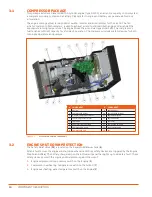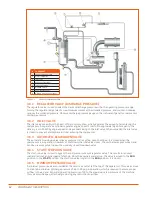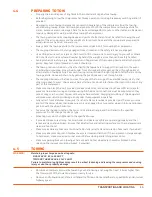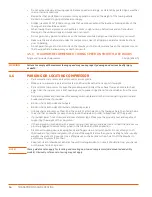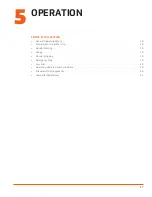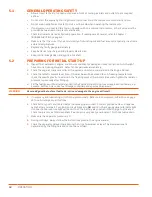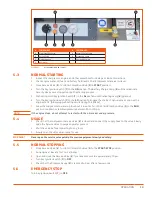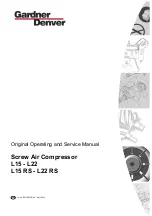
4
SAFETy
1.5
TOXIC AND IRRITATING SUBSTANCES
WARNING!
Do not use air from this compressor for breathing air. Breathing unfiltered air from this compressor can
result in serious injury or death.
NOTE!
Under specific guidelines and in full compliance with OSHA Standards 29 CFR 1920 and any other federal,
state, or local codes or regulations compressed air can be used for breathing air. Sullivan-Palatek does
not provide equipment and instructions for this application and its products are not produced for this
application or use.
»
Operate the compressor only in open or well-ventilated areas.
»
Carbon monoxide will kill. If the machine is operated indoors, discharge the engine exhaust outdoors and
be certain there are no exhaust system leaks that can discharge exhaust within the building.
»
Locate the compressor so that exhaust will not be carried toward personnel, air intakes servicing
personnel areas or toward the air intake of any other portable or stationary compressor.
»
Fuel, oil, coolant, lubricant, and battery electrolyte used in the compressor are typical of the industry.
Care should be taken to avoid accidental ingestion or skin or eye contact. In the event of ingestion or
contact, seek medical treatment promptly. Do not induce vomiting if fuel is ingested. Wash with soap
and water in the event of skin contact.
»
Wear an acid-resistant apron and a face shield or goggles when servicing the battery. If electrolyte is
spilled on skin or clothing, immediately flush and wash with large quantities of water.
»
Do not use airline anti-icing systems in airlines supplying respirators or other breathing air utilization
and equipment, and do not discharge air from these systems in unventilated or other confined areas.
»
Wear goggles or a full face shield when adding anti-freeze compound to air line anti-icing systems.
The
anti-freeze compound used in airline anti-icing systems contains methanol and is toxic, harmful, or
fatal if swallowed. Avoid contact with the skin or eyes and avoid breathing the fumes. If contact with
eyes, wash eyes with large quantities of clean water for at least 15 minutes. Medical attention should be
obtained immediately. If swallowed, induce vomiting by administering a tablespoon of salt in a glass of
clean, warm water until vomit is clear, then administer two teaspoons of baking soda in a glass of clean
water. Lay down and cover eyes to exclude light. Seek medical assistance.
»
Do not store airline anti-icing system anti-freeze compound in operator’s cabs or in unapproved
containers.
»
Do not mix different types of antifreeze. The mixture may cause a chemical reaction and release harmful
substances.
1.6
HOT SURFACES, SHARP EDGES, SHARP CORNERS AND VACUUM
»
Avoid contact with hot oil, hot coolant, hot surfaces, and sharp edges and corners.
»
Keep all parts of the body away from all points of air discharge and away from hot exhaust gases.
»
Wear personal protective equipment, including gloves, safety glasses and head covering when working
in, on, or around the compressor.
»
Keep a first aid kit available. Seek medical assistance promptly in case of injury. Do not ignore small cuts
and burns–these may lead to infection.
»
Keep all loose clothing and parts of the body away from engine and/or compressor intakes or air filter
intakes.
1.7
ELECTRICAL SHOCK
»
Keep the towing vehicle or equipment carrier, compressor hoses, tools, and all personnel at least 10 feet
from power lines and buried cables. Greater separation from power lines may be prudent when working
around high voltage. Contact the utility company for guidance.
»
Keep all parts of the body, any hand-held tools, or other conductive objects away from exposed live
parts of the compressor electrical system. Maintain dry footing, stand on insulating surfaces and do not
contact any other portion of the compressor when making adjustments or repairs to exposed live parts
of the electrical system.
1.8
ENTRAPMENT
»
Make sure all personnel are out of compressor before closing and latching enclosure doors. Larger
compressors can hold a man. If it is necessary to enter the enclosure to perform service or adjustments,
secure the access door in the open position to avoid the possibility of others closing and latching the
door and inform personnel before entering the enclosure.
Summary of Contents for D110PKU
Page 4: ......
Page 6: ...vi About This Manual ...
Page 13: ...5 2 SPECIFICATIONS TOPICS IN THIS SECTION Technical Data 6 Dimensions 7 ...
Page 16: ...8 Specifications ...
Page 44: ...36 Troubleshooting ...
Page 48: ...40 Parts Catalog 8 6 ENGINE ASSEMBLY ...
Page 50: ...42 Parts Catalog 8 7 ENGINE MOUNTING ASSEMBLY ...
Page 52: ...44 Parts Catalog 8 8 ENGINE TO FRAME ASSEMBLY ...
Page 54: ...46 Parts Catalog 8 9 BATTERY ASSEMBLY ...
Page 56: ...48 Parts Catalog 8 10 EXHAUST ASSEMBLY ...
Page 58: ...50 Parts Catalog 8 11 COMPRESSOR ASSEMBLY ...
Page 60: ...52 Parts Catalog 8 12 INLET VALVE ASSEMBLY ...
Page 62: ...54 Parts Catalog 8 13 AIR FILTER ASSEMBLY ...
Page 64: ...56 Parts Catalog 8 14 RECEIVER ASSEMBLY ...
Page 66: ...58 Parts Catalog 8 15 RECEIVER ASSEMBLY TO FRAME ...
Page 68: ...60 Parts Catalog 8 16 CONTROL TUBING ASSEMBLY ...
Page 70: ...62 Parts Catalog 8 17 COOLING ASSEMBLY ...
Page 72: ...64 Parts Catalog 8 18 COOLING ASSEMBLY ATTACHMENT TO FRAME ...
Page 74: ...66 Parts Catalog 8 19 COOLING SYSTEM HOSES AND RECOVERY TANK INSTALLATION ...
Page 76: ...68 Parts Catalog 8 20 OIL FILTER AND DISCHARGE HOSE ASSEMBLY ...
Page 78: ...70 Parts Catalog 8 21 FUEL TANK ASSEMBLY ...
Page 80: ...72 Parts Catalog 8 22 INSTRUMENT PANEL ASSEMBLY ...
Page 82: ...74 Parts Catalog 8 23 CANOPY ASSEMBLY ...
Page 84: ...76 Parts Catalog 8 24 CANOPY INSTALLATION ...
Page 86: ...78 Parts Catalog 8 25 LIFTING BAIL ASSEMBLY ...
Page 88: ...80 Parts Catalog 8 26 FRONT CROSSMEMBER ASSEMBLY ...
Page 90: ...82 Parts Catalog 8 27 LIGHT PACKAGE ...
Page 92: ...84 Parts Catalog 8 28 FENDER INSTALLATION ...
Page 94: ...86 Parts Catalog 8 29 AXLE AND WHEEL ASSEMBLY ...
Page 98: ...NOTES ...
Page 99: ...NOTES ...


















